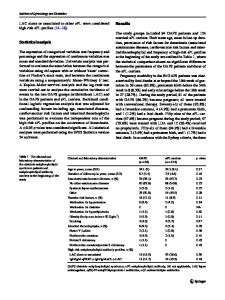Intensity of immune/clotting assays relate to multiple antiphospholipid antibody positivity in thrombotic primary antiph
- PDF / 533,014 Bytes
- 7 Pages / 595.276 x 790.866 pts Page_size
- 73 Downloads / 287 Views
ORIGINAL ARTICLE
Intensity of immune/clotting assays relate to multiple antiphospholipid antibody positivity in thrombotic primary antiphospholipid syndrome Paul R. J. Ames1,2 · Mira Merashli3 · Bucci Tommaso4,5 · Luigi Iannaccone6 · Vincenzo Marottoli6 · Antonio Ciampa7 Received: 10 June 2020 / Revised: 6 September 2020 / Accepted: 16 September 2020 © Japanese Society of Hematology 2020
Abstract The dual positivity (DP) and triple positivity (TP) concepts bypass the poor comparability of immune/clotting assay for the laboratory classification of antiphospholipid syndrome (APS). To evaluate intensity of immune/clotting assays and DP/TP through different clinical severity groups (CSG) as follows: (1) non-thrombotic asymptomatic carriers of aPL (N-THR), thrombotic primary APS (THR), deceased (D) for recurrent and fatal thrombosis. Activated partial thromboplastin time ratio (aPTTr), dilute Russell viper venom time ratio (DRVVTr), IgG/IgM anticardiolipin (aCL) and anti β-2-glycoprotein-I (aβ2GPI). Participants: 33 N-THR, 64 THR and 11 D. The frequency of DP and TP (DRVVTr or aPTTr partnered with respective IgG aCL or aβ2GPI) increased across CSG (p = 0.006 and p = 0.003); mean DRVVTr and IgG aCL/aβ2GPI were always greater in TP versus non-TP within each CSG and progressively increased across the CSG. The intensity of individual lupus anticoagulants partnered with their corresponding IgG aPL related to the frequency of multiple positivity throughout CSG suggesting that of intensity of immune/clotting assays and multiple positivity are the different faces of the same diagnostic coin in our thrombotic PAPS cohort. Keywords Dual and triple positivity · Antiphospholipid · Lupus anticoagulant
Introduction
Paul R. J. Ames and Mira Merashli considered joint first authors. * Paul R. J. Ames [email protected] 1
Immune Response and Vascular Disease Unit, Cedoc, Nova Medical School/Faculdade de Ciências Médicas, Universidade NOVA de Lisboa, Lisbon, Portugal
2
Dumfries and Galloway Royal Infirmary, Dumfries, UK
3
Department of Rheumatology, American University of Beirut, Beirut, Lebanon
4
Department of Medicine, Division of Allergy and Clinical Immunology, University of Salerno, Salerno, Italy
5
Department of Clinical, Internal, Anaesthesiologic and Cardiovascular Sciences, Atherothrombosis Centre, Prima Clinica Medica, Sapienza University of Rome, Rome, Italy
6
Multimedica SRL, Naples, Italy
7
Haemostasis Unit, AORN “San Giuseppe Moscati”, Avellino, Italy
The primary antiphospholipid syndrome (PAPS) defines arterial and venous thrombosis in the presence and persistence of antiphospholipid antibodies (aPL) measured by immune and clotting assays in the absence of any underlying autoimmune or chronic inflammatory disorder [1]. The concept of double positivity (DP) [2] and triple positivity [TP] [3] for the laboratory diagnosis of APS has been introduced to obviate the lack of standardisation of the immunoassays [4]: in particular, TP patients that simultaneously harbour a lupus anticoagulant (LA) alongs
Data Loading...











